Positive Externality and Government Intervention in Economics
VerifiedAdded on 2022/11/28
|13
|2666
|190
AI Summary
The essay discusses various aspects related to different fields of economics, including positive externality, government intervention, the association between pay and age, reasons for faster economic growth, and the impact of a fall in money supply. It provides insights into these topics and their implications in the field of economics.
Contribute Materials
Your contribution can guide someone’s learning journey. Share your
documents today.
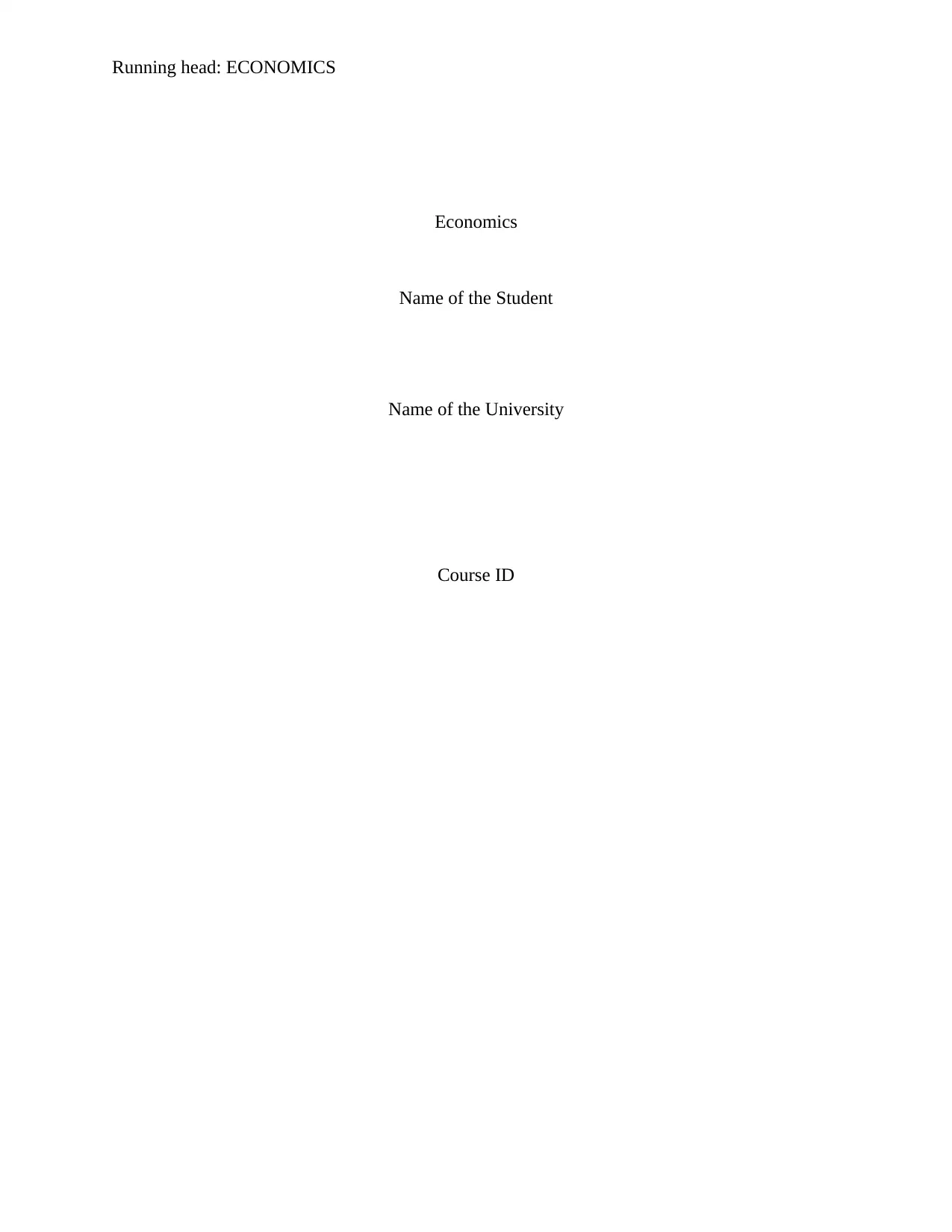
Running head: ECONOMICS
Economics
Name of the Student
Name of the University
Course ID
Economics
Name of the Student
Name of the University
Course ID
Secure Best Marks with AI Grader
Need help grading? Try our AI Grader for instant feedback on your assignments.
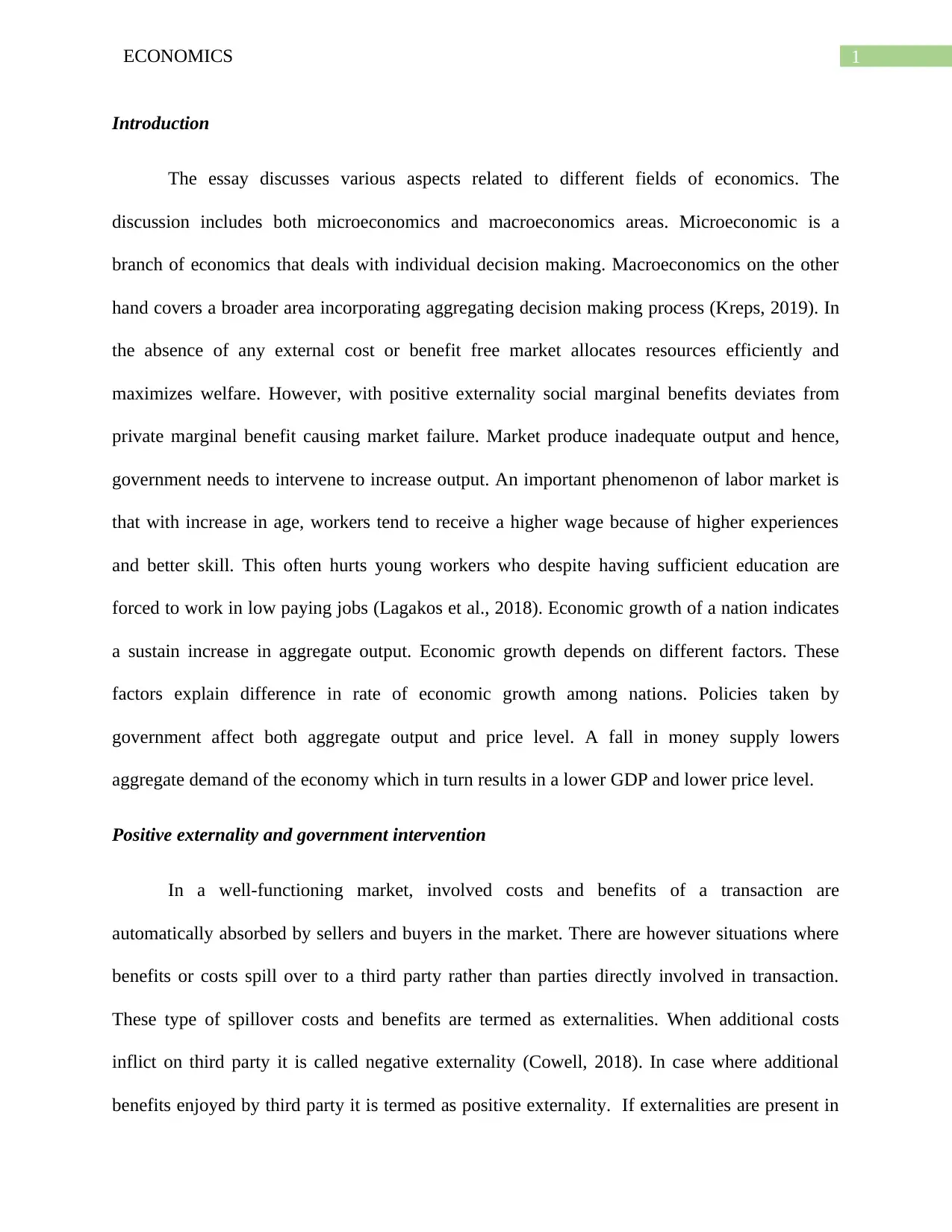
1ECONOMICS
Introduction
The essay discusses various aspects related to different fields of economics. The
discussion includes both microeconomics and macroeconomics areas. Microeconomic is a
branch of economics that deals with individual decision making. Macroeconomics on the other
hand covers a broader area incorporating aggregating decision making process (Kreps, 2019). In
the absence of any external cost or benefit free market allocates resources efficiently and
maximizes welfare. However, with positive externality social marginal benefits deviates from
private marginal benefit causing market failure. Market produce inadequate output and hence,
government needs to intervene to increase output. An important phenomenon of labor market is
that with increase in age, workers tend to receive a higher wage because of higher experiences
and better skill. This often hurts young workers who despite having sufficient education are
forced to work in low paying jobs (Lagakos et al., 2018). Economic growth of a nation indicates
a sustain increase in aggregate output. Economic growth depends on different factors. These
factors explain difference in rate of economic growth among nations. Policies taken by
government affect both aggregate output and price level. A fall in money supply lowers
aggregate demand of the economy which in turn results in a lower GDP and lower price level.
Positive externality and government intervention
In a well-functioning market, involved costs and benefits of a transaction are
automatically absorbed by sellers and buyers in the market. There are however situations where
benefits or costs spill over to a third party rather than parties directly involved in transaction.
These type of spillover costs and benefits are termed as externalities. When additional costs
inflict on third party it is called negative externality (Cowell, 2018). In case where additional
benefits enjoyed by third party it is termed as positive externality. If externalities are present in
Introduction
The essay discusses various aspects related to different fields of economics. The
discussion includes both microeconomics and macroeconomics areas. Microeconomic is a
branch of economics that deals with individual decision making. Macroeconomics on the other
hand covers a broader area incorporating aggregating decision making process (Kreps, 2019). In
the absence of any external cost or benefit free market allocates resources efficiently and
maximizes welfare. However, with positive externality social marginal benefits deviates from
private marginal benefit causing market failure. Market produce inadequate output and hence,
government needs to intervene to increase output. An important phenomenon of labor market is
that with increase in age, workers tend to receive a higher wage because of higher experiences
and better skill. This often hurts young workers who despite having sufficient education are
forced to work in low paying jobs (Lagakos et al., 2018). Economic growth of a nation indicates
a sustain increase in aggregate output. Economic growth depends on different factors. These
factors explain difference in rate of economic growth among nations. Policies taken by
government affect both aggregate output and price level. A fall in money supply lowers
aggregate demand of the economy which in turn results in a lower GDP and lower price level.
Positive externality and government intervention
In a well-functioning market, involved costs and benefits of a transaction are
automatically absorbed by sellers and buyers in the market. There are however situations where
benefits or costs spill over to a third party rather than parties directly involved in transaction.
These type of spillover costs and benefits are termed as externalities. When additional costs
inflict on third party it is called negative externality (Cowell, 2018). In case where additional
benefits enjoyed by third party it is termed as positive externality. If externalities are present in

2ECONOMICS
any transaction, then free market fail to allocate resources efficiently and market failure occurs.
In order to correct the market failure government should intervene in the market with appropriate
policy tool.
With a positive externality, marginal social benefit is greater than private marginal
benefit. An example of positive externality is the completion of high school education by a
student. When a student completes high school education, he/she can reap the benefits from high
education in the form of better job prospects, high productivity resulting in a higher income for
the person. These are however not the only benefits that come with high degree of education.
The effect of education spills over to the society causing a positive externality. For example, an
educated society can take a better decision for electing political leaders. Society with more
educated people tends to have relatively lower crime rates (Baumol & Blinder, 2015). Whenever
these kind of externalities are present free market cannot perform efficiently resulting in a market
failure. The figure below explains resulted market failure from positive externality.
any transaction, then free market fail to allocate resources efficiently and market failure occurs.
In order to correct the market failure government should intervene in the market with appropriate
policy tool.
With a positive externality, marginal social benefit is greater than private marginal
benefit. An example of positive externality is the completion of high school education by a
student. When a student completes high school education, he/she can reap the benefits from high
education in the form of better job prospects, high productivity resulting in a higher income for
the person. These are however not the only benefits that come with high degree of education.
The effect of education spills over to the society causing a positive externality. For example, an
educated society can take a better decision for electing political leaders. Society with more
educated people tends to have relatively lower crime rates (Baumol & Blinder, 2015). Whenever
these kind of externalities are present free market cannot perform efficiently resulting in a market
failure. The figure below explains resulted market failure from positive externality.
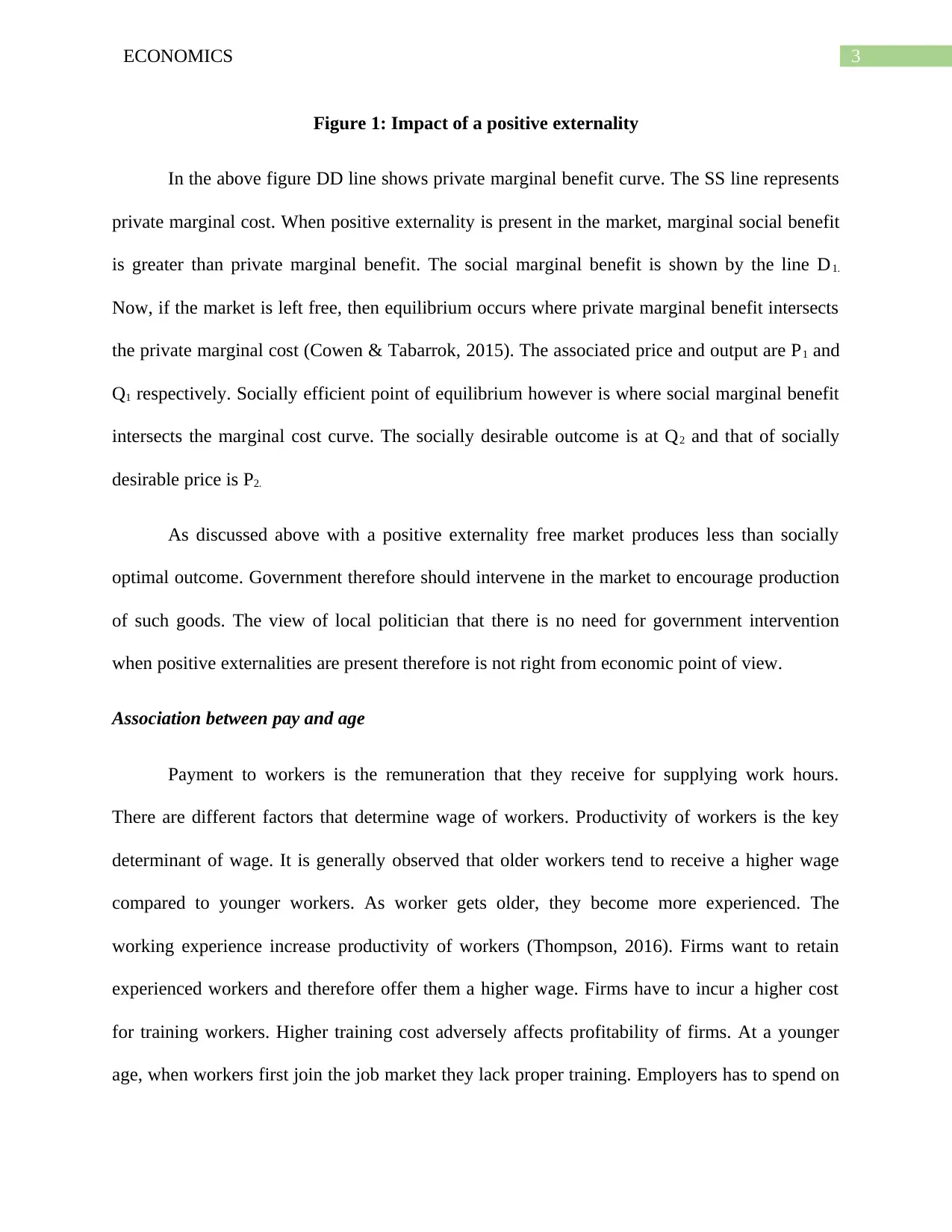
3ECONOMICS
Figure 1: Impact of a positive externality
In the above figure DD line shows private marginal benefit curve. The SS line represents
private marginal cost. When positive externality is present in the market, marginal social benefit
is greater than private marginal benefit. The social marginal benefit is shown by the line D1.
Now, if the market is left free, then equilibrium occurs where private marginal benefit intersects
the private marginal cost (Cowen & Tabarrok, 2015). The associated price and output are P1 and
Q1 respectively. Socially efficient point of equilibrium however is where social marginal benefit
intersects the marginal cost curve. The socially desirable outcome is at Q2 and that of socially
desirable price is P2.
As discussed above with a positive externality free market produces less than socially
optimal outcome. Government therefore should intervene in the market to encourage production
of such goods. The view of local politician that there is no need for government intervention
when positive externalities are present therefore is not right from economic point of view.
Association between pay and age
Payment to workers is the remuneration that they receive for supplying work hours.
There are different factors that determine wage of workers. Productivity of workers is the key
determinant of wage. It is generally observed that older workers tend to receive a higher wage
compared to younger workers. As worker gets older, they become more experienced. The
working experience increase productivity of workers (Thompson, 2016). Firms want to retain
experienced workers and therefore offer them a higher wage. Firms have to incur a higher cost
for training workers. Higher training cost adversely affects profitability of firms. At a younger
age, when workers first join the job market they lack proper training. Employers has to spend on
Figure 1: Impact of a positive externality
In the above figure DD line shows private marginal benefit curve. The SS line represents
private marginal cost. When positive externality is present in the market, marginal social benefit
is greater than private marginal benefit. The social marginal benefit is shown by the line D1.
Now, if the market is left free, then equilibrium occurs where private marginal benefit intersects
the private marginal cost (Cowen & Tabarrok, 2015). The associated price and output are P1 and
Q1 respectively. Socially efficient point of equilibrium however is where social marginal benefit
intersects the marginal cost curve. The socially desirable outcome is at Q2 and that of socially
desirable price is P2.
As discussed above with a positive externality free market produces less than socially
optimal outcome. Government therefore should intervene in the market to encourage production
of such goods. The view of local politician that there is no need for government intervention
when positive externalities are present therefore is not right from economic point of view.
Association between pay and age
Payment to workers is the remuneration that they receive for supplying work hours.
There are different factors that determine wage of workers. Productivity of workers is the key
determinant of wage. It is generally observed that older workers tend to receive a higher wage
compared to younger workers. As worker gets older, they become more experienced. The
working experience increase productivity of workers (Thompson, 2016). Firms want to retain
experienced workers and therefore offer them a higher wage. Firms have to incur a higher cost
for training workers. Higher training cost adversely affects profitability of firms. At a younger
age, when workers first join the job market they lack proper training. Employers has to spend on
Secure Best Marks with AI Grader
Need help grading? Try our AI Grader for instant feedback on your assignments.
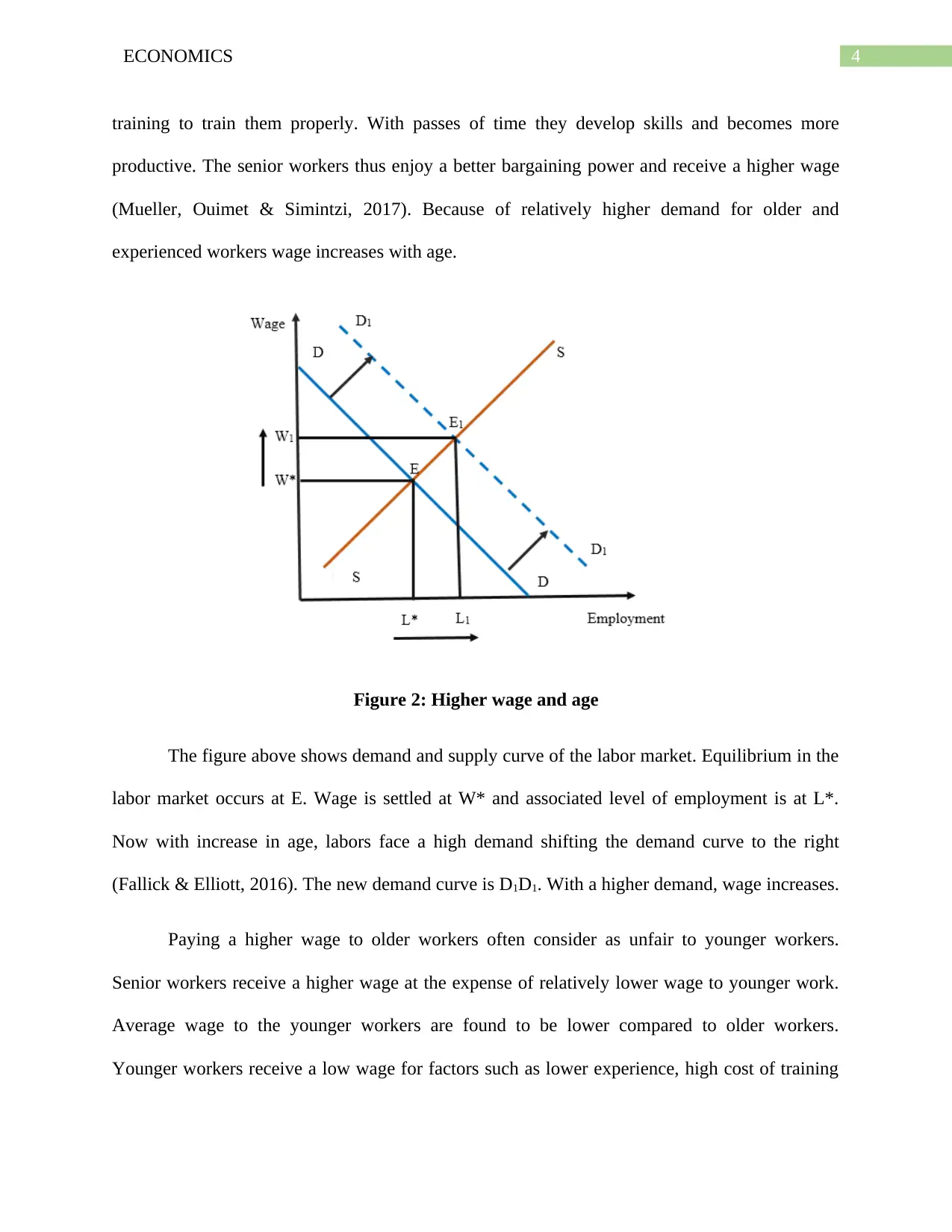
4ECONOMICS
training to train them properly. With passes of time they develop skills and becomes more
productive. The senior workers thus enjoy a better bargaining power and receive a higher wage
(Mueller, Ouimet & Simintzi, 2017). Because of relatively higher demand for older and
experienced workers wage increases with age.
Figure 2: Higher wage and age
The figure above shows demand and supply curve of the labor market. Equilibrium in the
labor market occurs at E. Wage is settled at W* and associated level of employment is at L*.
Now with increase in age, labors face a high demand shifting the demand curve to the right
(Fallick & Elliott, 2016). The new demand curve is D1D1. With a higher demand, wage increases.
Paying a higher wage to older workers often consider as unfair to younger workers.
Senior workers receive a higher wage at the expense of relatively lower wage to younger work.
Average wage to the younger workers are found to be lower compared to older workers.
Younger workers receive a low wage for factors such as lower experience, high cost of training
training to train them properly. With passes of time they develop skills and becomes more
productive. The senior workers thus enjoy a better bargaining power and receive a higher wage
(Mueller, Ouimet & Simintzi, 2017). Because of relatively higher demand for older and
experienced workers wage increases with age.
Figure 2: Higher wage and age
The figure above shows demand and supply curve of the labor market. Equilibrium in the
labor market occurs at E. Wage is settled at W* and associated level of employment is at L*.
Now with increase in age, labors face a high demand shifting the demand curve to the right
(Fallick & Elliott, 2016). The new demand curve is D1D1. With a higher demand, wage increases.
Paying a higher wage to older workers often consider as unfair to younger workers.
Senior workers receive a higher wage at the expense of relatively lower wage to younger work.
Average wage to the younger workers are found to be lower compared to older workers.
Younger workers receive a low wage for factors such as lower experience, high cost of training
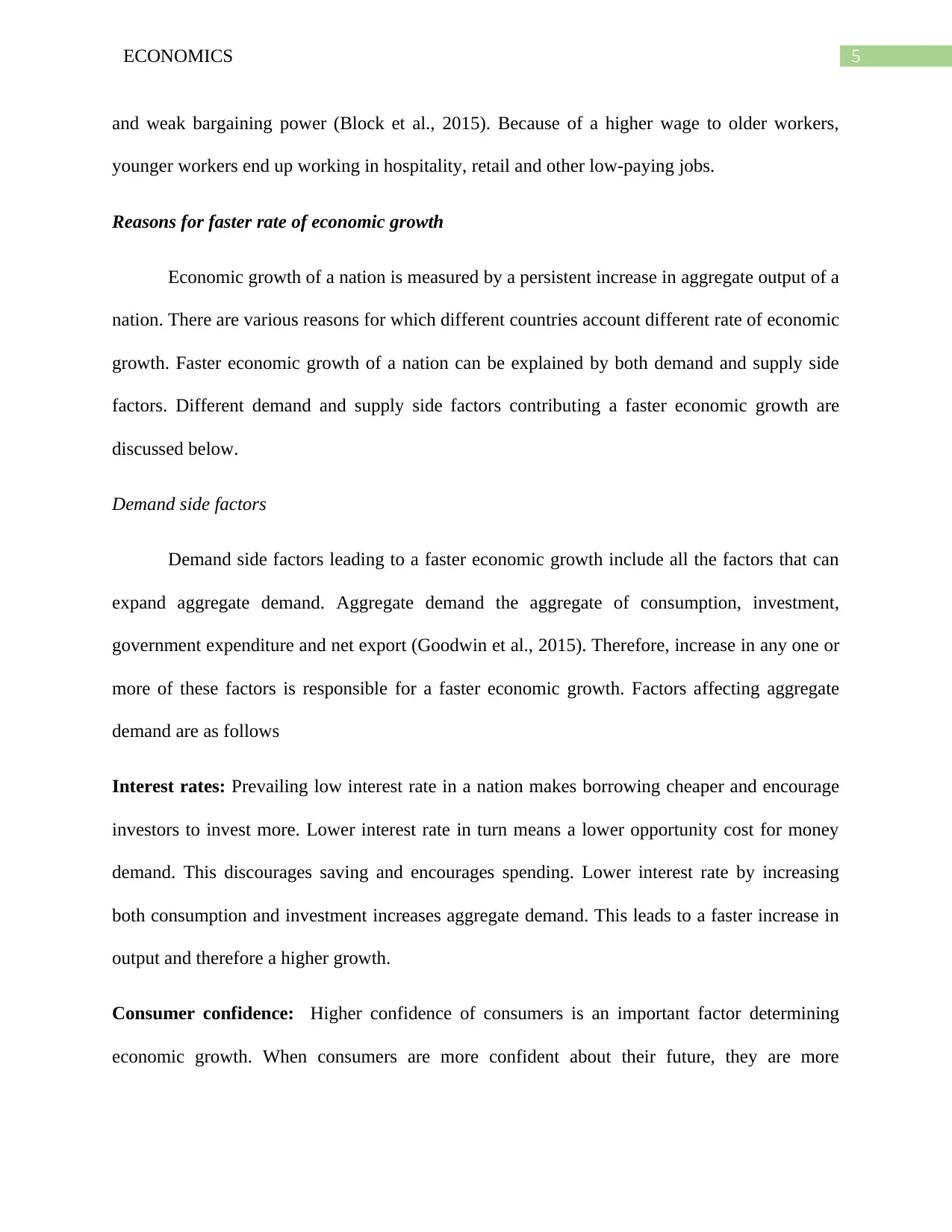
5ECONOMICS
and weak bargaining power (Block et al., 2015). Because of a higher wage to older workers,
younger workers end up working in hospitality, retail and other low-paying jobs.
Reasons for faster rate of economic growth
Economic growth of a nation is measured by a persistent increase in aggregate output of a
nation. There are various reasons for which different countries account different rate of economic
growth. Faster economic growth of a nation can be explained by both demand and supply side
factors. Different demand and supply side factors contributing a faster economic growth are
discussed below.
Demand side factors
Demand side factors leading to a faster economic growth include all the factors that can
expand aggregate demand. Aggregate demand the aggregate of consumption, investment,
government expenditure and net export (Goodwin et al., 2015). Therefore, increase in any one or
more of these factors is responsible for a faster economic growth. Factors affecting aggregate
demand are as follows
Interest rates: Prevailing low interest rate in a nation makes borrowing cheaper and encourage
investors to invest more. Lower interest rate in turn means a lower opportunity cost for money
demand. This discourages saving and encourages spending. Lower interest rate by increasing
both consumption and investment increases aggregate demand. This leads to a faster increase in
output and therefore a higher growth.
Consumer confidence: Higher confidence of consumers is an important factor determining
economic growth. When consumers are more confident about their future, they are more
and weak bargaining power (Block et al., 2015). Because of a higher wage to older workers,
younger workers end up working in hospitality, retail and other low-paying jobs.
Reasons for faster rate of economic growth
Economic growth of a nation is measured by a persistent increase in aggregate output of a
nation. There are various reasons for which different countries account different rate of economic
growth. Faster economic growth of a nation can be explained by both demand and supply side
factors. Different demand and supply side factors contributing a faster economic growth are
discussed below.
Demand side factors
Demand side factors leading to a faster economic growth include all the factors that can
expand aggregate demand. Aggregate demand the aggregate of consumption, investment,
government expenditure and net export (Goodwin et al., 2015). Therefore, increase in any one or
more of these factors is responsible for a faster economic growth. Factors affecting aggregate
demand are as follows
Interest rates: Prevailing low interest rate in a nation makes borrowing cheaper and encourage
investors to invest more. Lower interest rate in turn means a lower opportunity cost for money
demand. This discourages saving and encourages spending. Lower interest rate by increasing
both consumption and investment increases aggregate demand. This leads to a faster increase in
output and therefore a higher growth.
Consumer confidence: Higher confidence of consumers is an important factor determining
economic growth. When consumers are more confident about their future, they are more
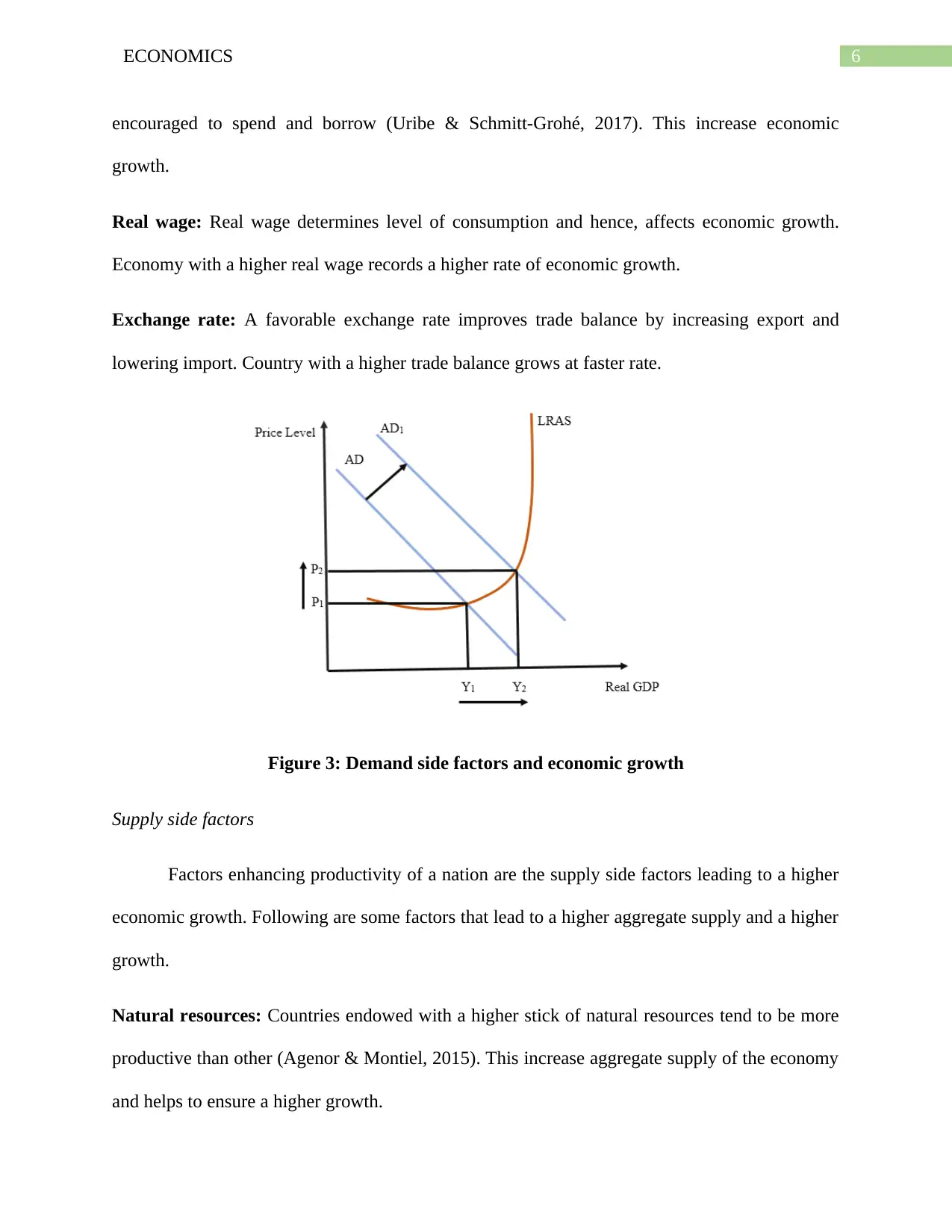
6ECONOMICS
encouraged to spend and borrow (Uribe & Schmitt-Grohé, 2017). This increase economic
growth.
Real wage: Real wage determines level of consumption and hence, affects economic growth.
Economy with a higher real wage records a higher rate of economic growth.
Exchange rate: A favorable exchange rate improves trade balance by increasing export and
lowering import. Country with a higher trade balance grows at faster rate.
Figure 3: Demand side factors and economic growth
Supply side factors
Factors enhancing productivity of a nation are the supply side factors leading to a higher
economic growth. Following are some factors that lead to a higher aggregate supply and a higher
growth.
Natural resources: Countries endowed with a higher stick of natural resources tend to be more
productive than other (Agenor & Montiel, 2015). This increase aggregate supply of the economy
and helps to ensure a higher growth.
encouraged to spend and borrow (Uribe & Schmitt-Grohé, 2017). This increase economic
growth.
Real wage: Real wage determines level of consumption and hence, affects economic growth.
Economy with a higher real wage records a higher rate of economic growth.
Exchange rate: A favorable exchange rate improves trade balance by increasing export and
lowering import. Country with a higher trade balance grows at faster rate.
Figure 3: Demand side factors and economic growth
Supply side factors
Factors enhancing productivity of a nation are the supply side factors leading to a higher
economic growth. Following are some factors that lead to a higher aggregate supply and a higher
growth.
Natural resources: Countries endowed with a higher stick of natural resources tend to be more
productive than other (Agenor & Montiel, 2015). This increase aggregate supply of the economy
and helps to ensure a higher growth.
Paraphrase This Document
Need a fresh take? Get an instant paraphrase of this document with our AI Paraphraser
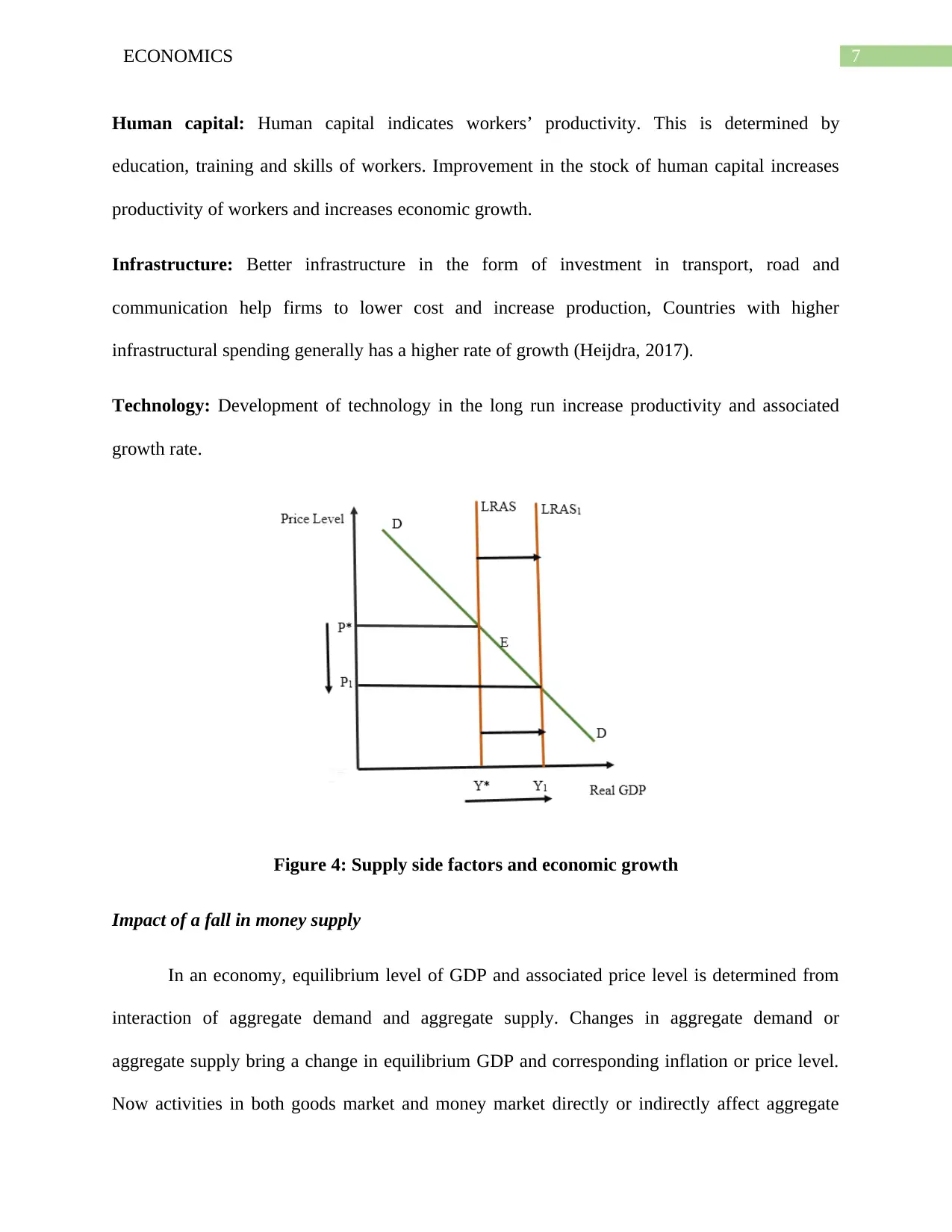
7ECONOMICS
Human capital: Human capital indicates workers’ productivity. This is determined by
education, training and skills of workers. Improvement in the stock of human capital increases
productivity of workers and increases economic growth.
Infrastructure: Better infrastructure in the form of investment in transport, road and
communication help firms to lower cost and increase production, Countries with higher
infrastructural spending generally has a higher rate of growth (Heijdra, 2017).
Technology: Development of technology in the long run increase productivity and associated
growth rate.
Figure 4: Supply side factors and economic growth
Impact of a fall in money supply
In an economy, equilibrium level of GDP and associated price level is determined from
interaction of aggregate demand and aggregate supply. Changes in aggregate demand or
aggregate supply bring a change in equilibrium GDP and corresponding inflation or price level.
Now activities in both goods market and money market directly or indirectly affect aggregate
Human capital: Human capital indicates workers’ productivity. This is determined by
education, training and skills of workers. Improvement in the stock of human capital increases
productivity of workers and increases economic growth.
Infrastructure: Better infrastructure in the form of investment in transport, road and
communication help firms to lower cost and increase production, Countries with higher
infrastructural spending generally has a higher rate of growth (Heijdra, 2017).
Technology: Development of technology in the long run increase productivity and associated
growth rate.
Figure 4: Supply side factors and economic growth
Impact of a fall in money supply
In an economy, equilibrium level of GDP and associated price level is determined from
interaction of aggregate demand and aggregate supply. Changes in aggregate demand or
aggregate supply bring a change in equilibrium GDP and corresponding inflation or price level.
Now activities in both goods market and money market directly or indirectly affect aggregate
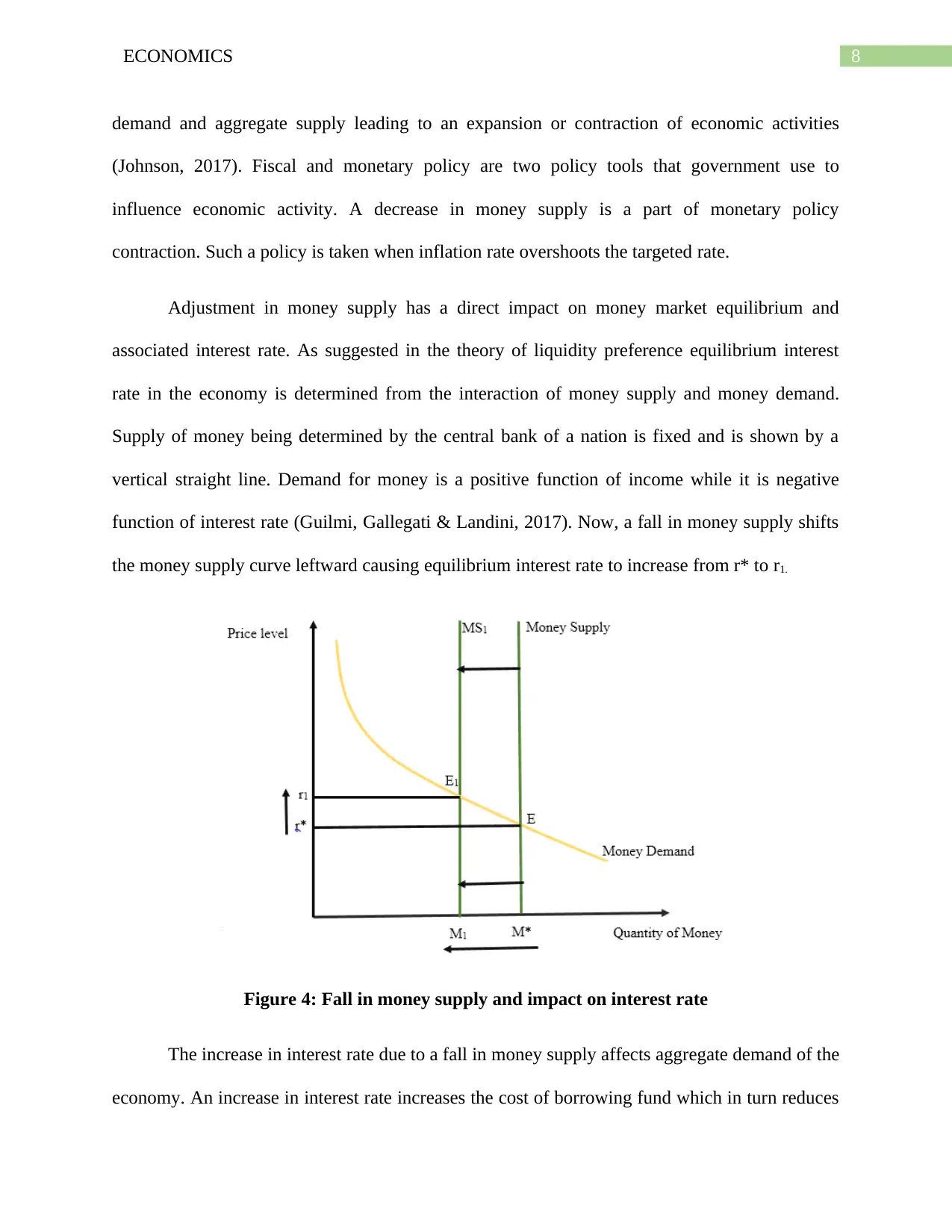
8ECONOMICS
demand and aggregate supply leading to an expansion or contraction of economic activities
(Johnson, 2017). Fiscal and monetary policy are two policy tools that government use to
influence economic activity. A decrease in money supply is a part of monetary policy
contraction. Such a policy is taken when inflation rate overshoots the targeted rate.
Adjustment in money supply has a direct impact on money market equilibrium and
associated interest rate. As suggested in the theory of liquidity preference equilibrium interest
rate in the economy is determined from the interaction of money supply and money demand.
Supply of money being determined by the central bank of a nation is fixed and is shown by a
vertical straight line. Demand for money is a positive function of income while it is negative
function of interest rate (Guilmi, Gallegati & Landini, 2017). Now, a fall in money supply shifts
the money supply curve leftward causing equilibrium interest rate to increase from r* to r1.
Figure 4: Fall in money supply and impact on interest rate
The increase in interest rate due to a fall in money supply affects aggregate demand of the
economy. An increase in interest rate increases the cost of borrowing fund which in turn reduces
demand and aggregate supply leading to an expansion or contraction of economic activities
(Johnson, 2017). Fiscal and monetary policy are two policy tools that government use to
influence economic activity. A decrease in money supply is a part of monetary policy
contraction. Such a policy is taken when inflation rate overshoots the targeted rate.
Adjustment in money supply has a direct impact on money market equilibrium and
associated interest rate. As suggested in the theory of liquidity preference equilibrium interest
rate in the economy is determined from the interaction of money supply and money demand.
Supply of money being determined by the central bank of a nation is fixed and is shown by a
vertical straight line. Demand for money is a positive function of income while it is negative
function of interest rate (Guilmi, Gallegati & Landini, 2017). Now, a fall in money supply shifts
the money supply curve leftward causing equilibrium interest rate to increase from r* to r1.
Figure 4: Fall in money supply and impact on interest rate
The increase in interest rate due to a fall in money supply affects aggregate demand of the
economy. An increase in interest rate increases the cost of borrowing fund which in turn reduces
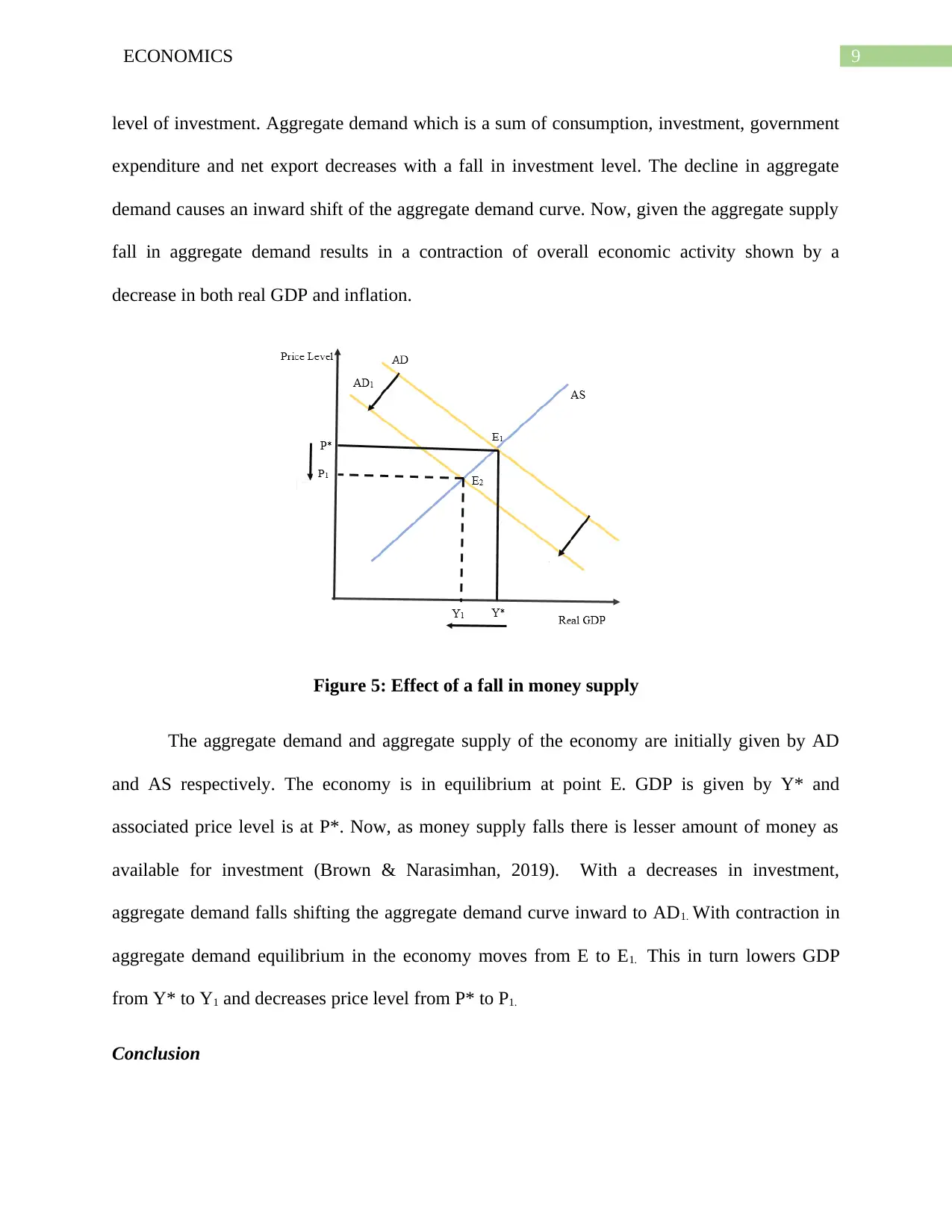
9ECONOMICS
level of investment. Aggregate demand which is a sum of consumption, investment, government
expenditure and net export decreases with a fall in investment level. The decline in aggregate
demand causes an inward shift of the aggregate demand curve. Now, given the aggregate supply
fall in aggregate demand results in a contraction of overall economic activity shown by a
decrease in both real GDP and inflation.
Figure 5: Effect of a fall in money supply
The aggregate demand and aggregate supply of the economy are initially given by AD
and AS respectively. The economy is in equilibrium at point E. GDP is given by Y* and
associated price level is at P*. Now, as money supply falls there is lesser amount of money as
available for investment (Brown & Narasimhan, 2019). With a decreases in investment,
aggregate demand falls shifting the aggregate demand curve inward to AD1. With contraction in
aggregate demand equilibrium in the economy moves from E to E1. This in turn lowers GDP
from Y* to Y1 and decreases price level from P* to P1.
Conclusion
level of investment. Aggregate demand which is a sum of consumption, investment, government
expenditure and net export decreases with a fall in investment level. The decline in aggregate
demand causes an inward shift of the aggregate demand curve. Now, given the aggregate supply
fall in aggregate demand results in a contraction of overall economic activity shown by a
decrease in both real GDP and inflation.
Figure 5: Effect of a fall in money supply
The aggregate demand and aggregate supply of the economy are initially given by AD
and AS respectively. The economy is in equilibrium at point E. GDP is given by Y* and
associated price level is at P*. Now, as money supply falls there is lesser amount of money as
available for investment (Brown & Narasimhan, 2019). With a decreases in investment,
aggregate demand falls shifting the aggregate demand curve inward to AD1. With contraction in
aggregate demand equilibrium in the economy moves from E to E1. This in turn lowers GDP
from Y* to Y1 and decreases price level from P* to P1.
Conclusion
Secure Best Marks with AI Grader
Need help grading? Try our AI Grader for instant feedback on your assignments.
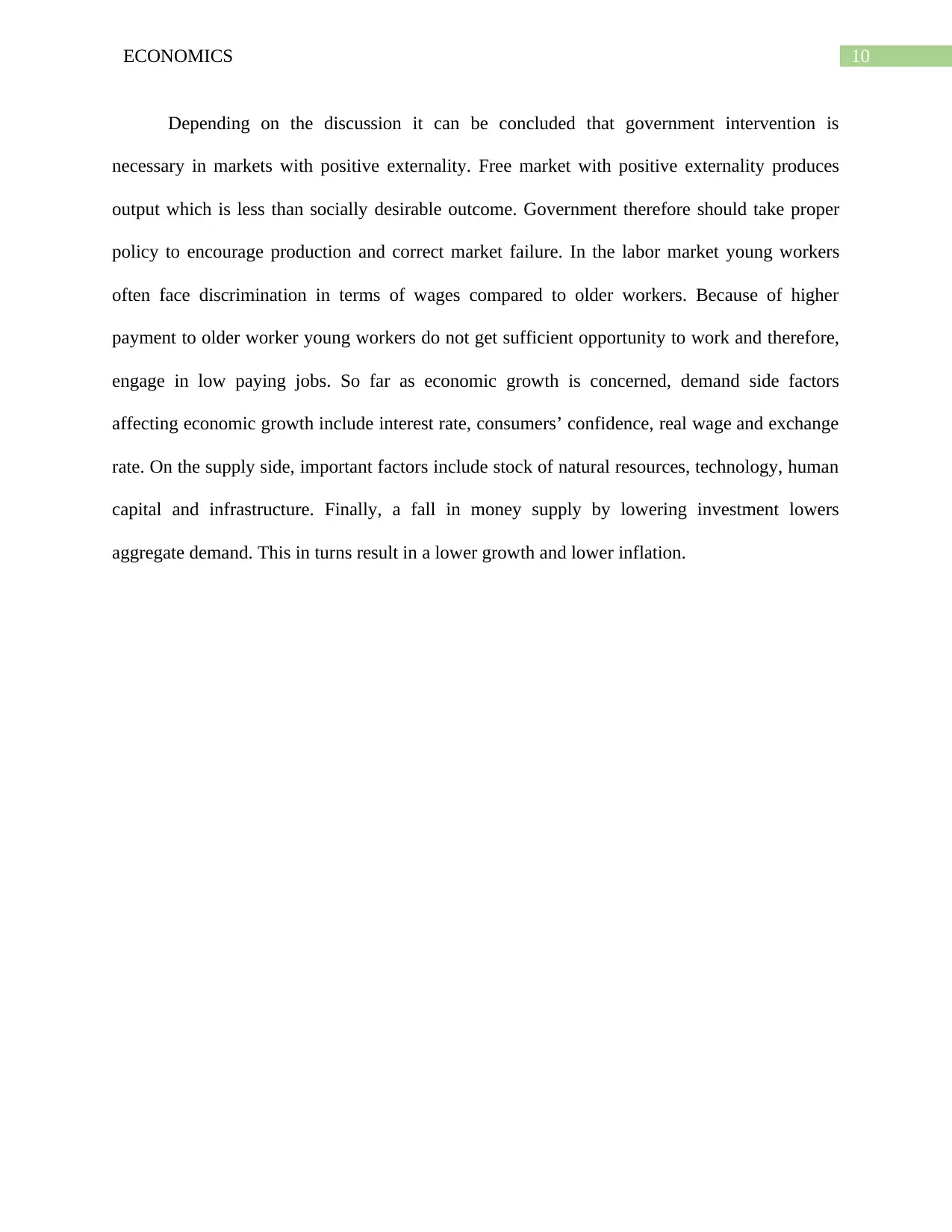
10ECONOMICS
Depending on the discussion it can be concluded that government intervention is
necessary in markets with positive externality. Free market with positive externality produces
output which is less than socially desirable outcome. Government therefore should take proper
policy to encourage production and correct market failure. In the labor market young workers
often face discrimination in terms of wages compared to older workers. Because of higher
payment to older worker young workers do not get sufficient opportunity to work and therefore,
engage in low paying jobs. So far as economic growth is concerned, demand side factors
affecting economic growth include interest rate, consumers’ confidence, real wage and exchange
rate. On the supply side, important factors include stock of natural resources, technology, human
capital and infrastructure. Finally, a fall in money supply by lowering investment lowers
aggregate demand. This in turns result in a lower growth and lower inflation.
Depending on the discussion it can be concluded that government intervention is
necessary in markets with positive externality. Free market with positive externality produces
output which is less than socially desirable outcome. Government therefore should take proper
policy to encourage production and correct market failure. In the labor market young workers
often face discrimination in terms of wages compared to older workers. Because of higher
payment to older worker young workers do not get sufficient opportunity to work and therefore,
engage in low paying jobs. So far as economic growth is concerned, demand side factors
affecting economic growth include interest rate, consumers’ confidence, real wage and exchange
rate. On the supply side, important factors include stock of natural resources, technology, human
capital and infrastructure. Finally, a fall in money supply by lowering investment lowers
aggregate demand. This in turns result in a lower growth and lower inflation.
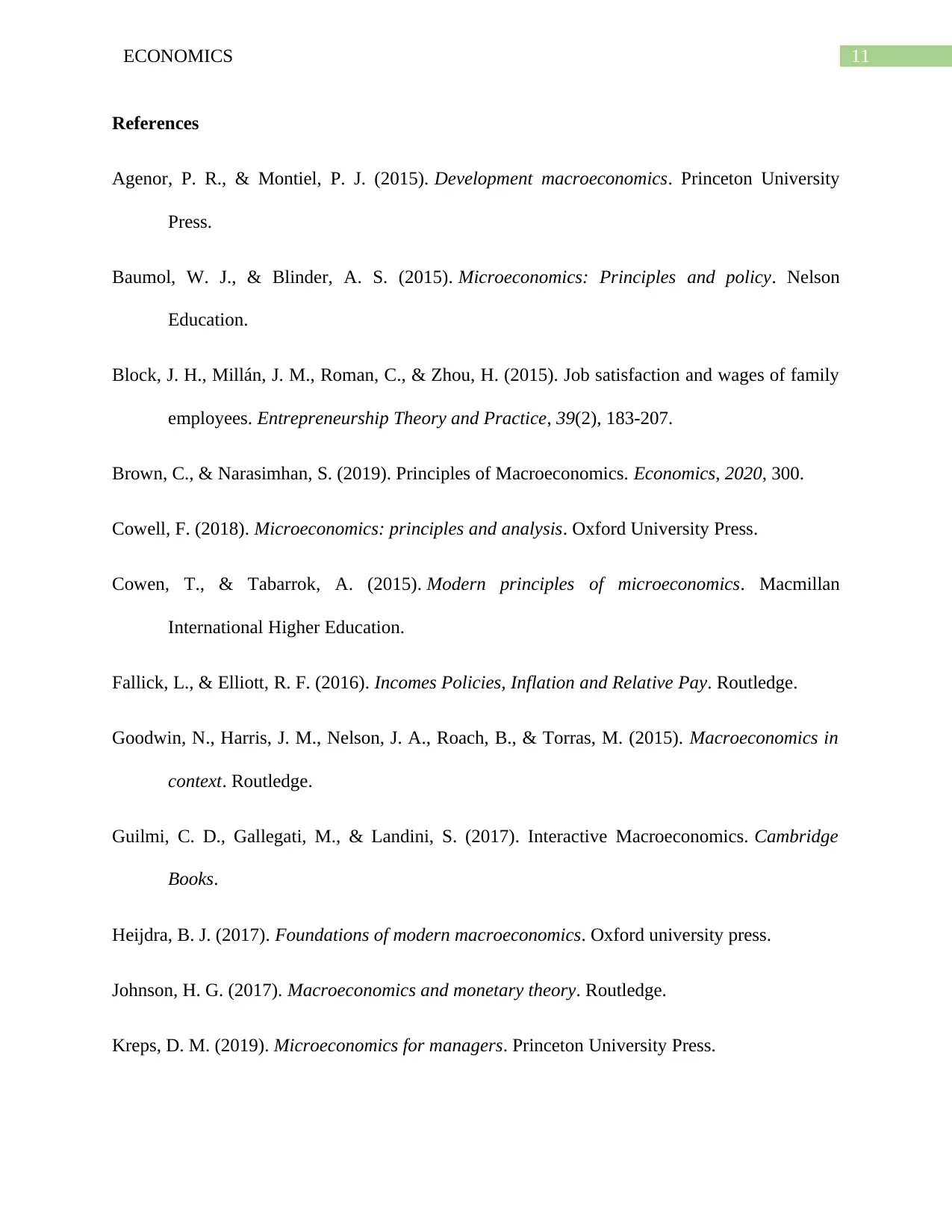
11ECONOMICS
References
Agenor, P. R., & Montiel, P. J. (2015). Development macroeconomics. Princeton University
Press.
Baumol, W. J., & Blinder, A. S. (2015). Microeconomics: Principles and policy. Nelson
Education.
Block, J. H., Millán, J. M., Roman, C., & Zhou, H. (2015). Job satisfaction and wages of family
employees. Entrepreneurship Theory and Practice, 39(2), 183-207.
Brown, C., & Narasimhan, S. (2019). Principles of Macroeconomics. Economics, 2020, 300.
Cowell, F. (2018). Microeconomics: principles and analysis. Oxford University Press.
Cowen, T., & Tabarrok, A. (2015). Modern principles of microeconomics. Macmillan
International Higher Education.
Fallick, L., & Elliott, R. F. (2016). Incomes Policies, Inflation and Relative Pay. Routledge.
Goodwin, N., Harris, J. M., Nelson, J. A., Roach, B., & Torras, M. (2015). Macroeconomics in
context. Routledge.
Guilmi, C. D., Gallegati, M., & Landini, S. (2017). Interactive Macroeconomics. Cambridge
Books.
Heijdra, B. J. (2017). Foundations of modern macroeconomics. Oxford university press.
Johnson, H. G. (2017). Macroeconomics and monetary theory. Routledge.
Kreps, D. M. (2019). Microeconomics for managers. Princeton University Press.
References
Agenor, P. R., & Montiel, P. J. (2015). Development macroeconomics. Princeton University
Press.
Baumol, W. J., & Blinder, A. S. (2015). Microeconomics: Principles and policy. Nelson
Education.
Block, J. H., Millán, J. M., Roman, C., & Zhou, H. (2015). Job satisfaction and wages of family
employees. Entrepreneurship Theory and Practice, 39(2), 183-207.
Brown, C., & Narasimhan, S. (2019). Principles of Macroeconomics. Economics, 2020, 300.
Cowell, F. (2018). Microeconomics: principles and analysis. Oxford University Press.
Cowen, T., & Tabarrok, A. (2015). Modern principles of microeconomics. Macmillan
International Higher Education.
Fallick, L., & Elliott, R. F. (2016). Incomes Policies, Inflation and Relative Pay. Routledge.
Goodwin, N., Harris, J. M., Nelson, J. A., Roach, B., & Torras, M. (2015). Macroeconomics in
context. Routledge.
Guilmi, C. D., Gallegati, M., & Landini, S. (2017). Interactive Macroeconomics. Cambridge
Books.
Heijdra, B. J. (2017). Foundations of modern macroeconomics. Oxford university press.
Johnson, H. G. (2017). Macroeconomics and monetary theory. Routledge.
Kreps, D. M. (2019). Microeconomics for managers. Princeton University Press.
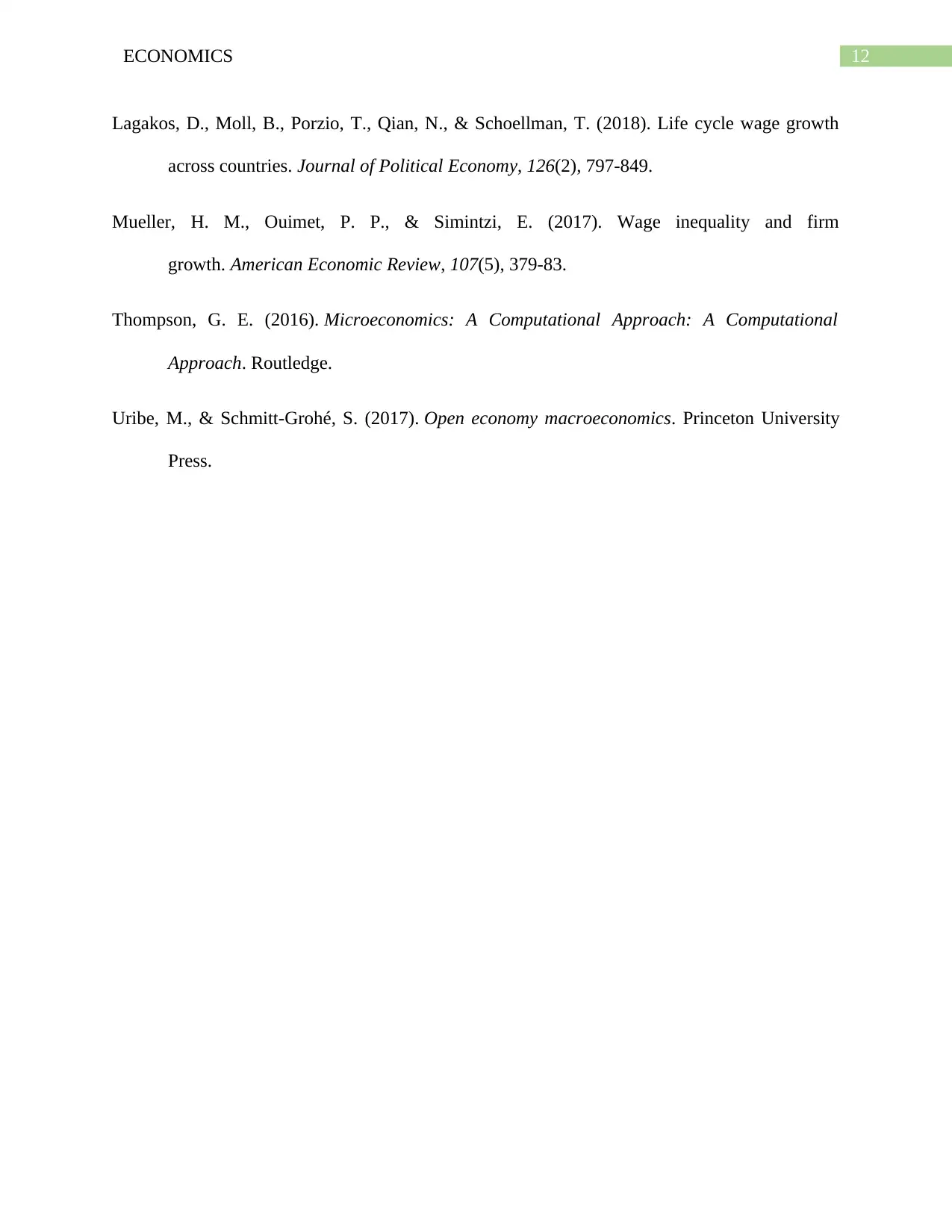
12ECONOMICS
Lagakos, D., Moll, B., Porzio, T., Qian, N., & Schoellman, T. (2018). Life cycle wage growth
across countries. Journal of Political Economy, 126(2), 797-849.
Mueller, H. M., Ouimet, P. P., & Simintzi, E. (2017). Wage inequality and firm
growth. American Economic Review, 107(5), 379-83.
Thompson, G. E. (2016). Microeconomics: A Computational Approach: A Computational
Approach. Routledge.
Uribe, M., & Schmitt-Grohé, S. (2017). Open economy macroeconomics. Princeton University
Press.
Lagakos, D., Moll, B., Porzio, T., Qian, N., & Schoellman, T. (2018). Life cycle wage growth
across countries. Journal of Political Economy, 126(2), 797-849.
Mueller, H. M., Ouimet, P. P., & Simintzi, E. (2017). Wage inequality and firm
growth. American Economic Review, 107(5), 379-83.
Thompson, G. E. (2016). Microeconomics: A Computational Approach: A Computational
Approach. Routledge.
Uribe, M., & Schmitt-Grohé, S. (2017). Open economy macroeconomics. Princeton University
Press.
1 out of 13
Related Documents
Your All-in-One AI-Powered Toolkit for Academic Success.
+13062052269
info@desklib.com
Available 24*7 on WhatsApp / Email
![[object Object]](/_next/static/media/star-bottom.7253800d.svg)
Unlock your academic potential
© 2024 | Zucol Services PVT LTD | All rights reserved.





